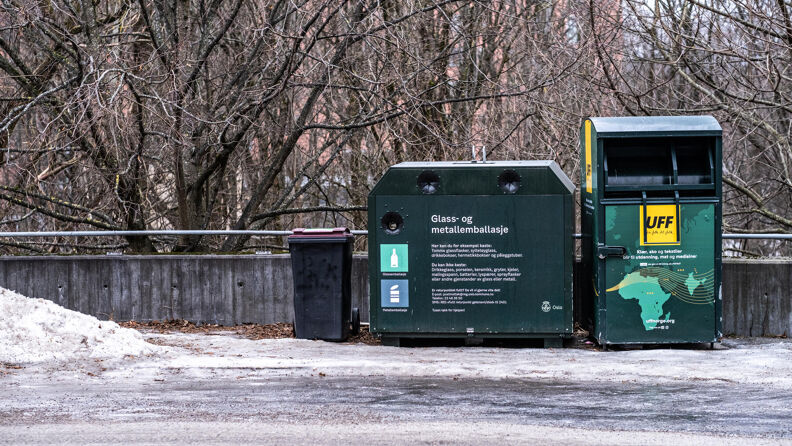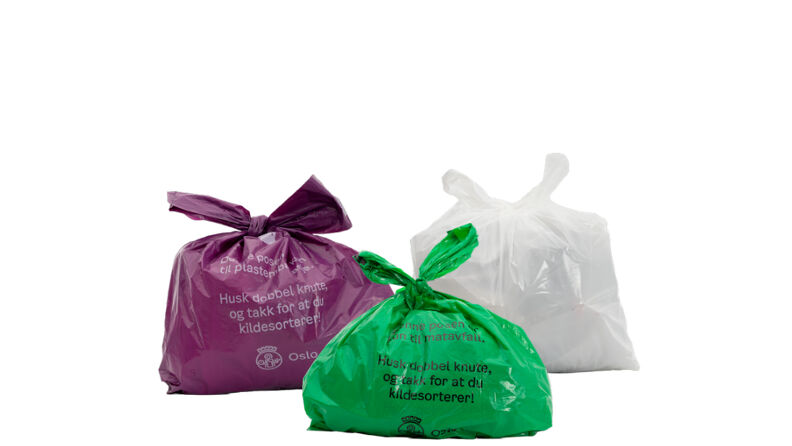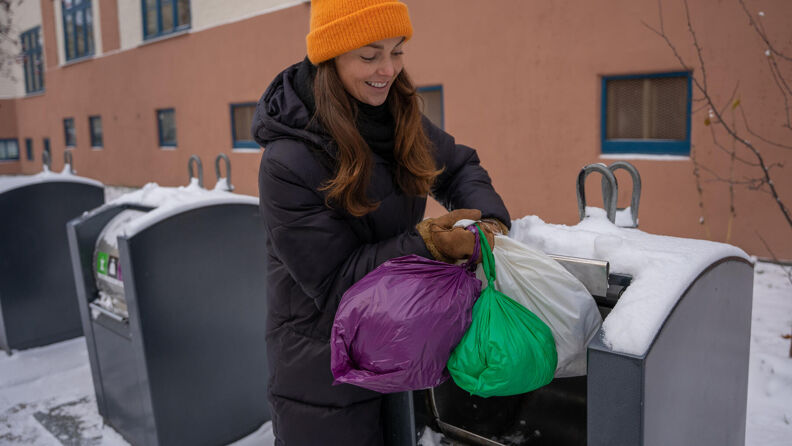How to recycle in Oslo
Find out where you can deliver different types of waste, and what kind of items you can recycle in the purple and green bags.
Plastic packaging, food waste, and residual waste
These three waste types are to be sorted in different waste bags, and put in the same container outside your home.
There's a purple bag for plastic packaging, and a green bag for food waste. You get the bags for free at most local convenience stores. Residual waste can be sorted in a normal grocery bag or waste bag. You can see pictures of the bags at the top of this article.
What's clean plastic packaging?
Remember to rinse the plastic waste if it is dirty.
- Plastic bags
- Plastic containers, plastic pots, plastic tubs
- Plastic packaging from meat/fish/fruit/vegetables etc.
- Plastic bottles for detergent/shampoo/sauces
- Plastic flowerpots
- Coffee bags/crisp packets without an aluminum inside
- Snuff pots
What's food waste?
- Peeling and cores
- Bread
- Teabags/coffee filters/coffee grounds
- Seafood, shells
- Leftovers meat/bones
- Eggshells
- Soiled tissue paper and napkins used for cooking/eating
What's residual waste?
- Nappies/diapers
- Pot plants/flowers (if you are not able to go to a garden waste facility)
- Candles
- Broken toys without electronics
- Ballpoint pens
- Worn out shoes
- Small pieces of polystyrene
- Cigarettes and snuff, cooled ashes/barbecue charcoal
- Soiled plastic and paper
Paper and cardboard
Every household has a separate container for paper and cardboard outside the house/building.
- Newspapers and envelopes, advertising material
- Magazines/books
- Milk and juice cartons
- Pizza and cereal boxes, and cardboard yoghurt packaging
- Cardboard kitchen roll/toilet roll tubes
- Quality wrapping paper (cheap, thin paper is residual waste)
Glass and metal packaging
Take it to a collection point for glass and metal packaging. There are over thousand of them spread around in Oslo.
- Alumimium packaging/foil, tea light cups
- Glass bottles
- Tin cans and metal tubes
- Metal caps and metal lids
- Non-deposit oil/mineral water cans
Textiles/clothes/shoes
Take it to a collection point for textiles, or deliver the waste at a recycling station. You can deliver both whole and wasted textiles.
- Clothes
- Useable shoes
- Towels, curtains and bedlinen
- Worn out fabric and clothes
Garden waste
Take this waste to a garden waste disposal point.
Typical garden waste:
- Grass, leaves, twigs/branches, weeds
- Windfall fruit
- Pot plants/flowers, Christmas trees.
EE waste and hazardous waste
EE waste
Take this waste to a recycling station, or return it to a retailer (it does not matter if you bought the item there, as long as they sell that type of goods).
- Batteries and light bulbs
- Electric toys, flashing shoes
- Mobile phones and computer equipment
- Electric razors and hairdryers
- Watches
- White goods
- Cables
Hazardous waste
Take it to a recycling station or an environmental waste station. Annual collection of hazardous waste.
- Impregnated wood
- Paint/wood stain/varnish
- Glue, white spirit, and chemicals
- Waste oil
- Cooking oil
Oversized waste
Take it to a recycling station. Wasted/broken items can be thrown in different containers at each station, while some functioning items can be delivered to the reuse sections.
- Broken furniture
- Car tyres
- Toilets, sinks, tubs
- Wood
- Scrap iron
- Plastic items
- Windows
- Larger amount of polystyrene
- Flooring
Reuse
Functioning items can be delivered to each station's reuse sections:
- Furniture and interior items
- Toys and children's equipment (like prams)
- Bikes, skis, and other sporting goods
- Books, CDs, and DVDs
- Lamps and other electronics, and more.
For households, the waste management fee covers:
- The collection and processing of sorted waste.
- Systems for waste collection in your local area.
- Self-delivery of waste to recycling stations.
- Self-delivery of waste to self-service receiving stations.




